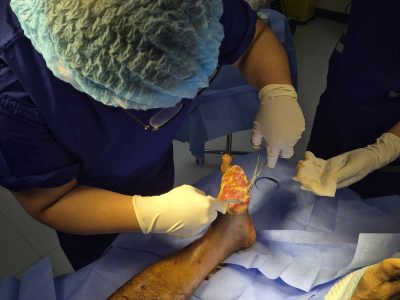Wound care is a critical part of medical treatment that can significantly impact a patient’s recovery, quality of life, and overall health. One vital component in wound management is the debridement procedure, a medical process that helps remove dead or infected tissue to promote healing. At Kalingap Wound Care Clinic, this procedure is not only performed with advanced medical techniques but also infused with Filipino values of kalinga (care) and lingap (nurture). This holistic and compassionate approach aims to treat not just the wound but also the person behind it, ensuring dignity and healing for every patient—especially those from underserved communities in Metro Manila.
What is Debridement?
The debridement procedure refers to the medical removal of dead, damaged, or infected tissue from a wound to accelerate the healing process. When wounds become chronic or infected, dead tissue can build up and prevent healthy tissue from growing. This can lead to infections, delayed healing, and further complications.
There are several types of debridement, each suited to different wounds and patient needs:
- Surgical debridement: Involves physically cutting away dead tissue with a scalpel or scissors. This is often the fastest method.
- Mechanical debridement: Uses physical forces like wet-to-dry dressings or irrigation to loosen and remove tissue.
- Enzymatic debridement: Applies topical enzymes to break down dead tissue chemically.
- Autolytic debridement: Utilizes the body’s own enzymes and moisture to digest necrotic tissue.
- Biological debridement: Employs sterile maggots that consume dead tissue but leave healthy tissue unharmed.
Each method has unique benefits and is selected based on the wound’s condition and the patient’s overall health.
How Does the Debridement Procedure Work?
The fundamental goal of the debridement procedure is to create an optimal environment for wound healing. Dead or necrotic tissue acts as a barrier, preventing new, healthy tissue from growing. Removing this tissue lowers the risk of infection by eliminating bacteria and reduces inflammation.
When dead tissue is cleared away, blood circulation improves, which brings oxygen and essential nutrients needed for repair. The process also allows medical professionals to better assess the wound and tailor treatments that promote regeneration.
Patients benefit from personalized treatment plans designed to maximize healing while minimizing discomfort. Whether through surgical precision or gentle enzymatic applications, the procedure supports the body’s natural recovery mechanisms.
Who Needs a Debridement Procedure?
Wounds that fail to heal properly often require a debridement procedure. Some common cases include:
- Diabetic ulcers: Individuals with diabetes may develop foot ulcers due to poor circulation and nerve damage. These wounds are prone to infection and need careful management.
- Pressure sores (bedsores): Prolonged pressure, especially in immobile patients, causes skin breakdown and ulcers that can become chronic.
- Burn wounds: Dead skin and tissue from burns must be removed to prevent infection.
- Chronic wounds: Any wound not healing within a typical timeframe might benefit from debridement to restart the healing process.
Certain factors increase the risk of poor wound healing, including advanced age, compromised immune systems, poor nutrition, and limited access to quality healthcare. These factors make compassionate and accessible wound care, like that provided at Kalingap Wound Care Clinic, particularly important for vulnerable populations in Metro Manila.
Debridement Procedure at Kalingap Wound Care Clinic
Kalingap Wound Care Clinic stands out by combining cutting-edge wound care technologies with a deep respect for Filipino values. The clinic’s philosophy centers on kalinga and lingap, translating to care and nurture, which permeate every aspect of patient interaction and treatment.
This means the debridement procedure is more than a technical medical intervention. It’s part of a holistic process that acknowledges the patient’s emotional, social, and cultural context. Patients are treated with kindness and empathy, recognizing the challenges that chronic wounds impose on dignity and daily life.
Accessibility is a key priority. The clinic offers its services to underserved communities in Metro Manila, ensuring that those who might otherwise face barriers to care can receive effective treatment. This mission empowers individuals to regain health and quality of life through compassionate wound management.
What to Expect During and After the Debridement Procedure
Preparation for the debridement procedure begins with a thorough evaluation of the wound and the patient’s overall health. The medical team explains the process, answers questions, and develops a tailored plan.
During the procedure, depending on the type used, patients may feel minimal discomfort or no pain at all. Pain management techniques, including local anesthesia or sedation, ensure comfort. The wound is carefully cleaned, and dead tissue is removed using the appropriate method.
After debridement, patients receive detailed instructions for wound care, including:
- Keeping the wound clean and dry
- Applying prescribed dressings or ointments
- Monitoring for signs of infection
- Scheduling follow-up visits to track healing progress
Proper post-procedure care is vital to prevent complications and support rapid recovery.
Benefits of Proper Debridement
When performed correctly and with compassion, the debridement procedure offers many benefits:
- Accelerated wound healing: Removing barriers allows healthy tissue to grow faster.
- Reduced infection risk: Eliminating dead tissue cuts down on bacteria that cause infections.
- Improved quality of life: Patients experience less pain and discomfort, restoring confidence and dignity.
- Holistic health improvement: By addressing wounds and patient well-being together, overall physical and emotional recovery is enhanced.
The Kalingap Wound Care Clinic’s model ensures that these benefits extend beyond physical healing, fostering trust and hope within the community.
Takeaway
Effective wound care is a cornerstone of healing, and the debridement procedure plays an essential role in that process. When performed with advanced medical expertise and deep compassion, as exemplified by Kalingap Wound Care Clinic, debridement transforms lives by restoring health, dignity, and hope.
By embracing Filipino values of kalinga and lingap, the clinic ensures that every patient—not just the wound—is nurtured with care. This commitment is especially crucial for underserved communities in Metro Manila who deserve access to high-quality, patient-centered care.
If you or a loved one is struggling with a chronic wound, seeking professional wound care and timely debridement can make all the difference. Healing starts with care—physical, emotional, and cultural.






